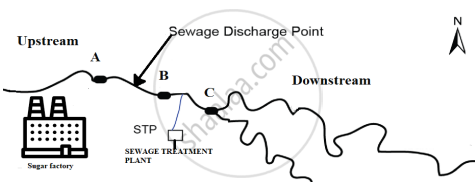Advertisements
Advertisements
Question
Water samples were collected at points A, B and C in a segment of a river near a sugar factory and tested for BOD level. The BOD levels of samples A, B and C were 400 mg/L, 480 mg/L and 8 mg/L respectively. What is this indicative of? Explain why the BOD level gets reduced considerably at the collection point C?

Solution
At collection points A and B, the BOD level is high due to high organic pollution caused by sugar factory and sewage discharge.
At the collection point C, the water was released after secondary treatment/ biological treatment (where vigorous growth of useful aerobic microbes into flocs consume the major part of the organic matter present in the river water or effluent due to sugar factory and sewage discharge).
APPEARS IN
RELATED QUESTIONS
Public all over India is very much concerned about the deteriorating air quality in large parts of North India. Alarmed by this situation the Resident's Welfare Association of your locality organized an awareness programme entitled "Bury not burn". They invited you, being a biology student to participate.
(a) How would you justify your arguments that promote burying and discourage burning? (Give two reasons)
(b) With the help of flow charts, one for each practice depict the chain of events that follow.
World’s most problematic aquatic weed is ______.
Which of the following exhibits biomagnification?
Which one of the following impurities is easiest to remove from wastewater?
Algal blooms impart a distinct colour to water due to ______.
Name an industry which can cause both air and thermal pollution and as well as eutrophication.
What is an algal bloom?
What do you understand by biomagnification?
What are the three major kinds of impurities in domestic wastewater?
Is it true that if the dissolved oxygen level drops to zero, the water will become septic. Give an example which could lower the dissolved oxygen content of an aquatic body.
